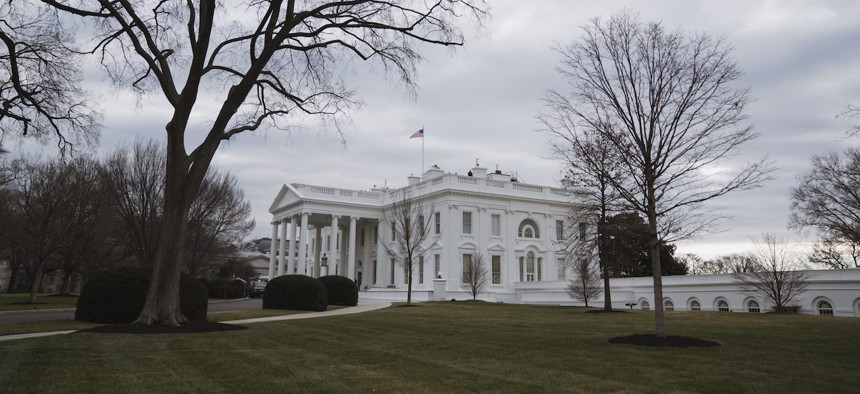
Eric Thayer/Getty Images
Want to reform the federal government? Start with career execs
COMMENTARY | Career senior executives are a national asset, not tools of agency heads. It’s time to manage them as the valuable resource they are, argues one expert.
Want to reform the federal government’s vast bureaucracy? Start at the top, with the Senior Executive Service. They set the tone—they personify the “trickle down” theory in organizations—but how to make them more responsive AND more efficient and effective? That is the question, and it will take more than a Schedule F to do so. It will require rethinking and “reforming” just how those execs are developed, promoted, deployed, rewarded, and retained.
No easy lift, but in so doing, we might just realize the original vision of the SES, first articulated by the late President Jimmy Carter and the principal architect of his civil service reforms, Scottie Campbell (the first OPM Director, as well as a friend and mentor), may they both rest in peace. They envisioned a mobile corps of senior career leaders moving purposefully across the whole of government—at the behest of the American citizens they were sworn to serve—to deal with its most interconnected, endemic, “wicked” problems.
Unfortunately, that’s a vision that has never been realized. And it is NOT going to be just by reissuing something like Schedule F, or by enacting some of the pay and performance management reforms suggested by my colleagues—although what I recommend is not incompatible with either. But what I advocate is much more fundamental, and it will take time to achieve. The good news is that it’s been done before.
All we need to do is look to the U.S. Intelligence Community’s revolutionary civilian “joint duty” program as a model. That program dramatically changed the entire life cycle for developing IC leaders, and in so doing, it better equipped them to “connect the dots” after the twin tragedies of 9/11 and the 2003 invasion of Iraq revealed unfortunate gaps in that regard. And now those leaders are much more able to devise and execute strategies to deal with today’s formidable, fundamentally interconnected threats to our Nation.
Unfortunately, those challenges are no longer limited to intelligence. The world around us has changed dramatically, typified by the interconnectedness of everything. COVID 19 and other public health challenges are but one of a whole host of examples that include immigration and border security, breakthrough technologies like CRISPR and artificial intelligence, global warming and climate change, a rising China and bellicose Russia, etc.
Simply put, we are all connected, and the world we find ourselves in requires career government executives (among other leaders) who are not just narrow subject matter experts. Rather, we are in desperate need of leaders who can address the Whole of Government/Whole of Nation challenges that characterize this brave new world. That was the prescient vision of Carter and Campbell back in 1978, but why now?
Well, there was a little something that happened last November (the presidential election, remember?) and the country—including OMB and OPM—has new leadership. Coincidentally, we are also celebrating the 20th anniversary of the Intelligence Reform and Terrorism Act, signed into law by George W. Bush in 2004, and that law may just have one of the answers to our current problems.
In that regard, I’ve just served as guest editor for an issue of the CIA’s Journal of Intelligence Studies providing a retrospective of that law . I also co-authored an article in that issue on the IC’s civilian “joint duty” program, and in my view, the latter bears further consideration as a governmentwide model.
The IC’s approach, patterned after one pioneered by the U.S. military, is quite straightforward. At its root, that model, like its military counterpart, requires at least one yearlong interagency (or equivalent) assignment as a prerequisite for promotion to one of the thousands of executive-level positions in the IC’s six senior services. The ultimate goal of these ‘out of body’ experiences was to create a network of trusted interpersonal relationships that would serve as the IC’s connective tissue when it came to information sharing...and where appropriate, action both covert and otherwise.
Above all else, that model requires something every SES member signs up for: Individual mobility—geographic, functional, organizational, etc.—but in the IC’s case, it must be acquired before someone is even eligible to be considered, much less selected to senior executive rank.
That program was specifically authorized by the IRTPA, hence the connection, and it was patterned after the one forced on our military (yes, forced!) by the Goldwater-Nichols Act of 1985. But unlike that law, the IRTPA did not give the Office of the Director of National Intelligence, where I’d just gone to work shortly after the IRTPA was signed, the authority to go with that authorization. That was deliberate. Indeed, it has been all too common in Washington, a signal that Congress had to leave it to bureaucrats like me to figure it out.
That authority was not the only one left vague by the IRTPA, but we ODNI “plank owners” knew that going in. That deliberate ambiguity led to many years of frustration, all recounted in gory detail in the stories linked above, but my purpose in writing this is not to rehash history. Rather, it’s to urge that the basic elements of that model be adapted and adopted for the entire SES corps.
Why should our nation’s new leaders take on something this disruptive (as it surely will be)? Because in the view of many, including myself, our brave new world requires it. To belabor the point, everything and everyone is now connected, and we need career execs who can discern and act upon that fact.
But as in most things like this, it is easier said than done. Here’s the heavy lifting that I think is required:
First and foremost, OPM needs to begin establishing and requiring a sixth Executive Core Qualification that denotes skill and experience in leading inter (interagency, interdepartmental, intergovernmental, international, etc.) operations.
Such an ECQ is essential, especially at the top of the SES—for example, for those who are Direct Reports to agency heads—so that may be a way of phasing it in. But it is critical, nevertheless. The IC has one (we called it Leading the Intelligence Enterprise), and it was fundamentally new, not just involving temporary coalitions (something in the current ECQ model), but a new skill denoting the creation of a more permanent, sustainable network of trusted relationships amongst key actors outside of an exec’s chain of command.
And like its five brethren, that sixth ECQ should be accompanied by a series of empirically derived sub-competencies—things like the ability to lead across external organizations without formal authority, an intimate knowledge of the various institutions and actors in an enterprise, the skill to deliberately build and leverage trusted social networks amongst those institutions and actors, etc.
All of these are required in today’s world, and most of them can only be acquired through some sort of developmental assignment...in other words, joint duty.
Lastly, such a model requires a bureaucracy to oversee it, and I do not mean that in a pejorative sense. Those who choose this new leadership path must do so formally, as part of a competitive, merit-based admissions process, and their development as potential agency leaders cannot be left to their own personal motivations and circumstances.
Here again, we can look to the U.S. military for guidance, as it has “managed” joint duty assignments amongst its eligible uniformed officer corps to meet the prerequisites for flag promotion established by Goldwater-Nichols. SES promotions are no less important and should thus be similarly managed.
In my view, that IC model—which I personally (and painfully) helped implement when I was the IC’s Chief Human Capital Officer back in 2005—was unprecedented, especially insofar as it developed leaders for the entire Community and the Nation, not (just) their individual agencies. That is something that is still too rare in the too-stove-piped federal government. More importantly, that program has had much to do with creating a true “culture of collaboration” in the IC, something we need across the board.
Bottom line: Our career senior executives should be considered a valued and valuable national resource, a “corporate” one that is managed accordingly...and not the chattel of the individual agency heads and cabinet secretaries who appoint them.
Ronald Sanders is a former career senior federal executive of more than 20 years. He is also a Fellow of the National Academy of Public Administration and a member of the American Society for Public Administration’s National Council. He has served as chair of the Federal Salary Council, associate director of OPM, DOD Director of Civilian Personnel Policy, IRS Chief HR Officer, and the Intelligence Community’s first Associate Director of National Intelligence for Human Capital.






